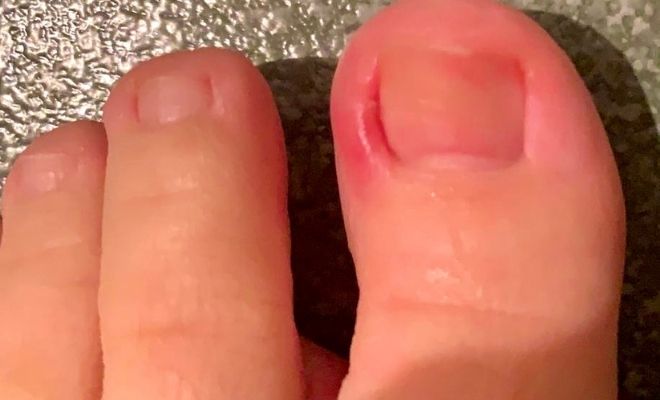How much are you capable of suffering in your feet for putting on a high heel from a chic brand? Whatever it takes while maintaining the glamour! But everything has a price…
One of the most common pathologies in the feet, and in a higher percentage in women between 20 and 40 years of age, is the ingrown toenail or onychocryptosis (also commonly known as ingrown toenail), although it can manifest itself throughout our lives in any moment.
It is a nail that digs into any of the nail edges, being very painful due to the inflammation it causes, becoming infected in most cases if it is not treated on time and properly and interrupting our ability to even walk in cases more serious.
High heels and other causes for which you can have an ingrown toenail
- The causes of this pathology are several, beginning with poor nail cutting, genetic factors, excessive sweating, the particular way that each of us walks and, above all, the type of footwear that we usually wear.
- Focusing on one of the causes that most causes this unbearable condition, we came to a difficult decision. High heels or ingrown toenail? Are we making use of the famous phrase ‘ to show off you have to suffer ‘?
- There is no doubt that high-heeled shoes with more than 3 or 4 cm do not fall within the recommendations that a podiatrist can give to wear correctly, but the big brands continue to manufacture, paying more attention to aesthetics and fashion than to comfort.
- It is normal, since we cannot ignore that a high-heeled shoe feels better, it stylizes much more and it is a mood booster to look in the mirror and feel that the clothes fit you well. Now, what is the solution to this heels yes or heels no controversy? Should we empty our cupboards of harmful shoes and wear shoes with a 3cm heel that is adequate for the correct biomechanics of the foot?
- I don’t think so, the problem, as in almost everything, is the abuse. As a podiatrist, it is clear that I cannot recommend the 11 cm heel for daily life, but I do not recommend removing it from our sight either, since it is an essential element of our wardrobe with a history written in the world of fashion. I am more in favor of recommending not to abuse and that manufacturers add noble materials and elements to this type of shoes that improve their comfort.
- It is important to understand that when we wear a high-heeled shoe that distinguishes the figure, elongates the legs and sculpts the buttocks, there is an increase in the load in the forefoot area, especially in the metatarsal area. This causes our nails, which have a job of distributing pressure and helping to take off the march, that these pressures increase on the skin surrounding the nail (the nail edges). If we add these compressive forces to those produced by the shoe through its materials in the toecap, especially in the narrower models with a fine toe and we are regulars in this type of footwear on a daily basis, we will have a great chance of ending up suffering from Hallux Valgus (bunion) or ingrown toenail.
Ingrown toenail symptoms
One must be very attentive to the signs and symptoms caused by this pathology, especially in the big toe when the nail is beginning to dig in. Redness, inflammation, pain, heat, scaling, and when it comes to a more serious infection, pus formation, are clear signs and symptoms that we may be suffering from the onset of onychocryptosis or incarnate toenail.
Treatment of the ingrown nail and the importance of going to the podiatrist
- The ingrown nail can be classified according to its severity in different stages and it is very important for the success of the conservative treatment to treat it in its beginnings. The greater the inflammation and pain, waiting for spontaneous recovery, the more difficult it will be for the podiatrist to extract the piece of nail called the spicule that may be causing this alteration in the tissues adjacent to it.
- The correct option is to go to a specialized health professional such as, in this case, the podiatrist, who, in addition to removing the spicule, will clean the area well, eliminating tissue remains or debris, will use special and sterile instruments and material, prescribing antibiotic therapy if necessary. necessary and will follow up until the total recovery of the nail.
- Sometimes, there are people in whom the pathology is repeated over time and surgical intervention is the most appropriate and determining option.
Recommendations to prevent nails from digging in
- Cut the nails straight as far as possible, filing any possible peaks that may have been left with a soft file.
- Use straight nose pliers if possible, special for cutting nails.
- Wear shoes that have enough space in the forefoot, so that the fingers have freedom of movement and do not suffer excessive pressure or chafing.
- Avoid sweating. Continued moisture on the feet causes the nail to dig in as the skin around the nail softens and is easier to penetrate.
- Wear footwear with natural materials that allow the foot to breathe and have adequate elasticity.
- If we may have a genetic predisposition to suffer an ingrown toenail because we know of a case in our family, go to a podiatrist so that through different techniques such as orthonyxia we can anticipate the development of this common and unpleasant pathology.
Foot care should be given the importance it deserves, it is the only part of the body that is in continuous contact with the ground, enduring pressures that other parts of the body do not.
Going to the podiatrist for an annual review is never too much, we do it in other specialties such as gynecology, the dentist… Why not at the podiatrist? Let us be guided by a professional and stay away from aesthetic centers when we have to treat any type of problem of this magnitude. The most prepared professional for the study, diagnosis and treatment of the foot is the podiatrist.









